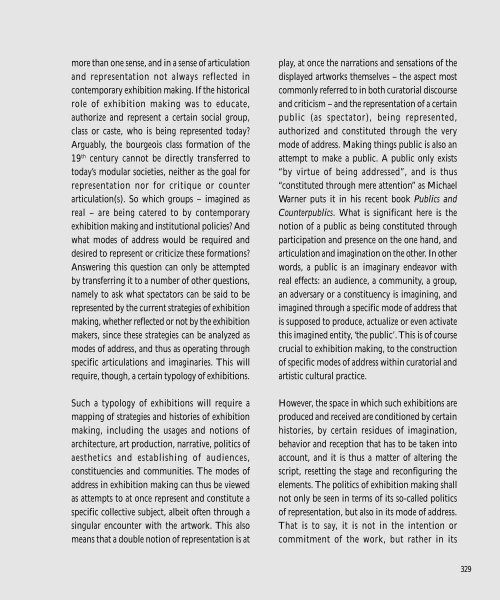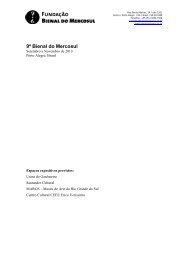Arte e Educação - Fundação Bienal do Mercosul
Arte e Educação - Fundação Bienal do Mercosul
Arte e Educação - Fundação Bienal do Mercosul
You also want an ePaper? Increase the reach of your titles
YUMPU automatically turns print PDFs into web optimized ePapers that Google loves.
more than one sense, and in a sense of articulation<br />
and representation not always reflected in<br />
contemporary exhibition making. If the historical<br />
role of exhibition making was to educate,<br />
authorize and represent a certain social group,<br />
class or caste, who is being represented today?<br />
Arguably, the bourgeois class formation of the<br />
19 th century cannot be directly transferred to<br />
today’s modular societies, neither as the goal for<br />
representation nor for critique or counter<br />
articulation(s). So which groups – imagined as<br />
real – are being catered to by contemporary<br />
exhibition making and institutional policies? And<br />
what modes of address would be required and<br />
desired to represent or criticize these formations?<br />
Answering this question can only be attempted<br />
by transferring it to a number of other questions,<br />
namely to ask what spectators can be said to be<br />
represented by the current strategies of exhibition<br />
making, whether reflected or not by the exhibition<br />
makers, since these strategies can be analyzed as<br />
modes of address, and thus as operating through<br />
specific articulations and imaginaries. This will<br />
require, though, a certain typology of exhibitions.<br />
Such a typology of exhibitions will require a<br />
mapping of strategies and histories of exhibition<br />
making, including the usages and notions of<br />
architecture, art production, narrative, politics of<br />
aesthetics and establishing of audiences,<br />
constituencies and communities. The modes of<br />
address in exhibition making can thus be viewed<br />
as attempts to at once represent and constitute a<br />
specific collective subject, albeit often through a<br />
singular encounter with the artwork. This also<br />
means that a <strong>do</strong>uble notion of representation is at<br />
play, at once the narrations and sensations of the<br />
displayed artworks themselves – the aspect most<br />
commonly referred to in both curatorial discourse<br />
and criticism – and the representation of a certain<br />
public (as spectator), being represented,<br />
authorized and constituted through the very<br />
mode of address. Making things public is also an<br />
attempt to make a public. A public only exists<br />
“by virtue of being addressed”, and is thus<br />
“constituted through mere attention” as Michael<br />
Warner puts it in his recent book Publics and<br />
Counterpublics. What is significant here is the<br />
notion of a public as being constituted through<br />
participation and presence on the one hand, and<br />
articulation and imagination on the other. In other<br />
words, a public is an imaginary endeavor with<br />
real effects: an audience, a community, a group,<br />
an adversary or a constituency is imagining, and<br />
imagined through a specific mode of address that<br />
is supposed to produce, actualize or even activate<br />
this imagined entity, ‘the public’. This is of course<br />
crucial to exhibition making, to the construction<br />
of specific modes of address within curatorial and<br />
artistic cultural practice.<br />
However, the space in which such exhibitions are<br />
produced and received are conditioned by certain<br />
histories, by certain residues of imagination,<br />
behavior and reception that has to be taken into<br />
account, and it is thus a matter of altering the<br />
script, resetting the stage and reconfiguring the<br />
elements. The politics of exhibition making shall<br />
not only be seen in terms of its so-called politics<br />
of representation, but also in its mode of address.<br />
That is to say, it is not in the intention or<br />
commitment of the work, but rather in its<br />
329




